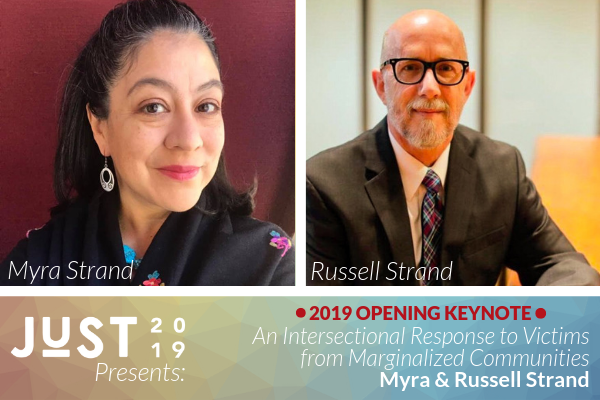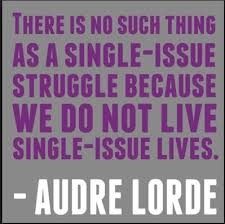
We are excited to announce that we have invited Russell and Myra Strand to join us again on the JuST Conference plenary stage, this time as our Opening Keynote!
Russell and Myra will be presenting, An Intersectional Response to Victims from Marginalized Communities on Tuesday, October 15 at this year’s JuST (Juvenile Sex Trafficking) Conference in Cincinnati, OH. Visit justconference.org/just2019 to review our workshop agenda and for more information on how to register.
Interested in learning more? Review their blog post below.
An Intersectional Response to Victims from Marginalized Communities
By Myra and Russell Strand
In December of 2015, the U.S. Department of Justice announced new guidance designed to help law enforcement agencies (LEAs) prevent gender bias in their response to sexual assault and domestic violence.
“One critical part of improving LEAs’ response to allegations of sexual assault and domestic violence is identifying and preventing gender bias in policing practices. Gender bias in policing practices is a form of discrimination that may result in LEAs providing less protection to certain victims on the basis of gender, failing to respond to crimes that disproportionately harm people of a particular gender or offering reduced or less robust services due to a reliance on gender stereotypes.
Gender bias, whether explicit or implicit, conscious or unconscious, may include police officers misclassifying or underreporting sexual assault or domestic violence cases, or inappropriately concluding that sexual assault cases are unfounded; failing to test sexual assault kits; interrogating rather than interviewing victims and witnesses; treating domestic violence as a family matter rather than a crime; failing to enforce protection orders; or failing to treat same-sex domestic violence as a crime. In the sexual assault and domestic violence context, if gender bias influences the initial response to or investigation of the alleged crime, it may compromise law enforcement’s ability to ascertain the facts, determine whether the incident is a crime, and develop a case that supports effective prosecution and holds the perpetrator accountable”. (U.S. Department of Justice 2015).
In order to implement their focus, they articulated and recommended the need for clear policies, robust training and responsive accountability systems.
As LEAs’ are seeking to address gender bias, allied professionals (prosecutors, defense attorneys, advocates, forensic nurses, social workers, probation, jail staff…) also seek to address gender bias as the entire criminal justice system is a symbiotic mechanism. This is progressive and essential because the occurrence of gender bias in the criminal justice system is well measured and frequent.
This an absolute step in the right direction because we know that those identifying as female are disproportionately affected by the sex trafficking, thus making it a form of gender -based violence.
However, similar to responses for other forms of gender- based violence, there is a critical need to view sex trafficking through an intersectional lens to ensure that all responses are cognizant of and sensitive to the unique challenges and plights that one may experience as a result of their chosen and born identities. Thus, we would encourage the system to expand its analysis of bias to go beyond gender and incorporate an intersectional lens. Intersectionality refers to the simultaneous experience of categorical and hierarchical classifications including, but not limited to gender, race, class, orientation, nation status, health, ability, trauma history, age…(etc.).
It also asserts that what is often perceived as disparate forms of oppression, like racism, classism, sexism, and xenophobia are actually mutually dependent and intersecting in nature.
 In our society, marginalized individuals are at a higher risk for victimization (domestic violence, rape and sexual assault), abuse, trafficking. Marginalization is the process in which an individual or a group is kept (both with or without intention) in a powerless position within a society because they do not have identities that naturally warrant an active voice or place of status within it.
In our society, marginalized individuals are at a higher risk for victimization (domestic violence, rape and sexual assault), abuse, trafficking. Marginalization is the process in which an individual or a group is kept (both with or without intention) in a powerless position within a society because they do not have identities that naturally warrant an active voice or place of status within it.
Marginalization can show up in subtle or overt actions, such as using derogatory language, assuming someone’s accomplishments are not based on merit, and expecting individuals to act a certain way based on stereotypes.
As a system, there is consideration of bias as related to identities beyond gender. There is analysis exploring racial bias, there is research outlining the experience of marginalized and/or underserved populations, there is a wide body of knowledge supporting the impact of living in rural community or in poverty, there is research around being part of the LGBTQQIAA+ community while experiencing victimization…but most often the analysis is done through the lens of “solitary/ single identity” without consideration that we are complicated humans living with many identities simultaneously. Yet, we are generally still doing research in silos without meaningful cross-over or communication.
We cannot have a holistic human-centric trauma responsive conversation about bias if we don’t also include core identities beyond gender. Consider the case of Deeandra:
 She is a young Native American female living on a rural reservation in deep poverty with chronic mental health issues and a partner who practices violence in his relationship.
She is a young Native American female living on a rural reservation in deep poverty with chronic mental health issues and a partner who practices violence in his relationship.
She is experiencing gender bias from the criminal justice system. She is also experiencing bias related to her race, her mental health issues, to living in poverty and rural community. Simultaneously.
It is unquestionably essential that we explore ways to eradicate bias discrimination in a compassionate and empathetic manner through an intersectional lens. The discriminations we face are products of our unique positioning in society as determined by these complicated social classifiers. While it is good that our criminal justice system is taking Deeandra’s gender seriously as they seek to address bias, it would be more beneficial to her if we considered bias through an intersectional lens.
Working Bibliography:
Collins and Bilge (2016). Intersectionality. Cambridge, UK: Polity Press.
Finley and Thomsen. (2018). On Intersectionality: A Review Essay. https://www.doi.org/10.111/huypa.12450
Grzanka. (2014). Intersectionality: A Foundation and Frontiers Reader. Boulder, CO. Westview Press.
U.S. Department of Justice, Identifying and Preventing Gender Bias in Law Enforcement Response to Sexual Assault and Domestic Violence, December 15, 2015, https://www.justice.gov/opa/file/799366/download.
Myra Strand, MA, is a managing partner, along with her husband, of Strand² Squared LLC where she provides consultation, forensic experiential trauma interviewing, training and assistance to agencies and service providers. Myra began working with people who have complex trauma in 1995. She has experience with youth with complex trauma, people with developmental disabilities, youth in competing war zones, county inmates, in the area of death notification and with victims of all crime types. Myra has over a decade as a professor of ethnic and gender studies, intersectionality and issues of violence at NAU, Coconino Community College and at the County Detention Center. Myra is nationally recognized for her contribution to field complicated and often traumatic human services.
Senior Special Agent (Retired) Russell W. Strand, CFP-A, is a managing partner, along with his wife, of Strand² Squared LLC, is the creator of the Forensic Experiential Trauma Interview and is a member of the founding faculty as in independent consultant of Certified FETI. Russ began his career in 1975 as a military police officer, and then worked as a military police investigator until retiring 22 years later as a senior special agent in the U.S. Army Criminal Investigations Command. Next, Russ was appointed as the Chief of the U.S. Army Military Police Behavioral Sciences Education & Training Division where he worked for 20 years. Russ has distinguished himself as a professional, educator and a consultant and is internationally recognized for his leadership, his impact and vision.






